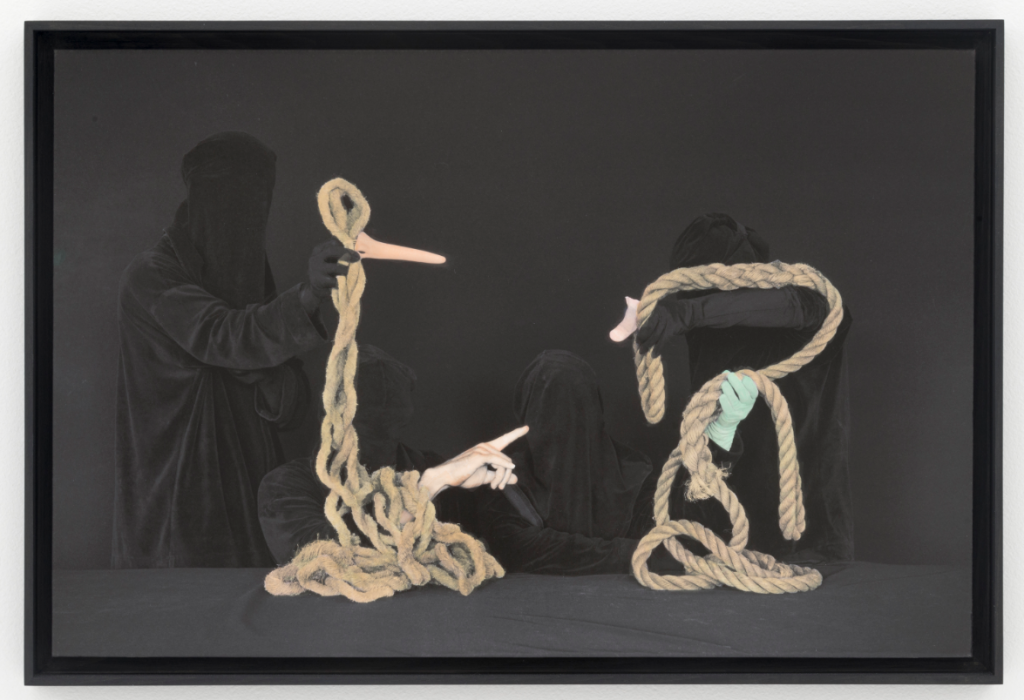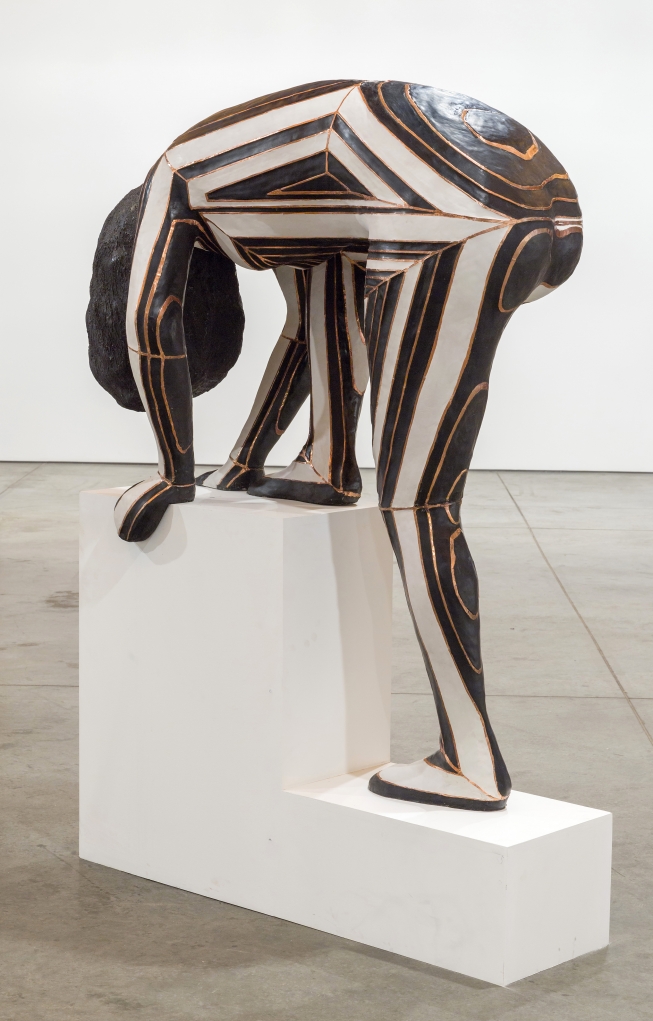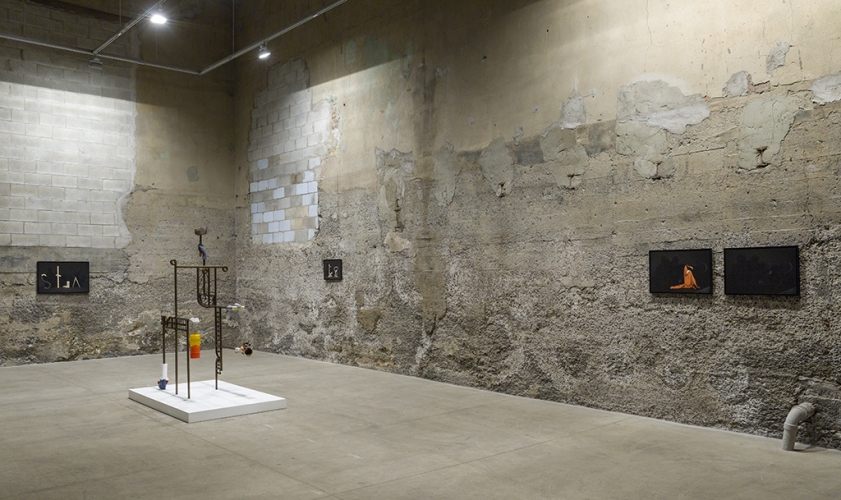Valérie Blass: In Conversation
by Tina Gelsomini
Valérie Blass is not easily classified as a sculptor, evidenced in her exhibition at Montreal’s Parisian Laundry where she is a represented artist. Blass is perhaps better described as a scavenger, an assembler of oddities, and a master puppeteer of materials.
Her most recent works came together at Parisian Laundry’s Théâtre d’Objets exhibition, which contained a combination of new work, alongside those already displayed at her first solo exhibition in New York last November. Others were commissioned for Public Art Fund’s 2012–13 exhibition at the Metrotech Center in Brooklyn. The exhibition, which recently closed in mid-February, makes full use of Parisian Laundry’s space, which occupies a three-story 15,000 square foot restored industrial building in Montréal. The magnificent Orca Gladiator, a larger than life-scale sculpture of a human figure with a distorted head, claimed the attention of the first floor, which also contains laser print of a similar figure on granite. The second floor held her series of cartoonish stick figures appearing as frozen fantastical woodland creatures, made largely from organic materials. One must descend into the dark cement basement of Parisian Laundry to encounter Valerie Blass’ most recent works, staged photographs of hooded black figures modeling the objects of Blass’s choosing. These haunting, cult-like images maintain Blass’ iconic use of found materials and distorted, unknowable figures, have manifested the artist in a fresh form.

Though coming from separate, albeit recent, moments in the artist’s creative life, the fourteen works of Théâtre d’Objets combine to create a thoroughly vivid portrait of the artist, her creative process, and her vision. Below is a short conversation I had the opportunity to hold with the incredibly busy artist, who is currently working on yet another commission, about her exhibition, her inspirations and her plans for future projects.
Tina Gelsomini: Many of your works, both those in Théâtre d’Objets and your earlier sculptures, appear as collages of found, reworked and reused objects. Could you tell us more about the process of hunting down these items?
Valérie Blass: I have the habit of collecting objects. I am constantly finding interesting things that may or may not end up in my work. I feel that I have become more precise when finding these objects of interest, things that are more intriguing in terms of their physical properties or their rarity. The objects that I tend to gravitate towards are objects that grab my attention because I do not necessarily understand them, or their purpose, yet they exist in this world. They clearly have some “raison d’être” but it is dated, out of use, impractical or strange looking. They often have some kind of humorous quality, or they may look like an old tool or some kind of decorative object combined with a practical object for everyday use.
TG: Does your vision for an individual sculpture precede the finding of an object, or do you scavenge first and let yourself become inspired by what turns up?
VB: My process is one that pushes and pulls between those two possibilities – envisioning a sculpture first or basing a sculpture off of objects I find. Yes I accumulate all sorts of objects and assemble them, but I also assemble and juxtapose ideas. And I often consider images of images and how that interplay can produce new forms and results. For example, I frequently juxtapose a number of aesthetics like a discontinuity between various visual languages – traditional modes of display, modernist aesthetics, or influences from art historical references. Because of this my process is one where I can shift between assembling objects that allow for both a continuity in assemblage but a discontinuity in inferred purpose. For example, Meuble mécanique in my recent exhibition, Théâtre d’Objets at Parisian Laundry reflected this. The sculpture is evocative of a piece of furniture – in fact the structure is cast in bronze from a re-assembled folding screen, but it is removed from its context to perform as an abstract sculpture, with real found objects and hyperrealist cast appendages (in the form of cast hands).

TG: Your two works, Orca Gladiator and Sculpture Bidon, are particularly intriguing. Orca is the largest, and the perhaps most commanding sculpture of Théâtre d’Objets, while Sculpture Bidon mimics its imagery through laser print on granite. What spurred your decision to echo this figure in another form?
VB: This question raises a good way to think about my work in general as these two sculptures present something that often occurs in my work in a very literal way.
The juxtaposition of aesthetics or objects that I spoke of earlier typically begins in the form of models or a photograph that I use to try and develop the idea for a work – a collage aesthetic is often generated. From that the “pattern” of the work is typically found and ends up in the three dimensional iteration of the work. This pattern moves through the three-dimensional surface of Orca gladiator – for example, it pierces the figure and from a distance creates what could be perceived as a 2-D uniform surface pattern. Here I started with an idea and a flat image that would become a sculpture [Orca Gladiator], and ultimately I returned to the image by creating a new surface for it in Sculpture bidon. I am always coming from one thing to the other, doubling and forcing resemblances are critical to my work, they enhance the oscillation between continuity and discontinuity.
TG: While different in execution, your series of prints (La partie pour la chose, La chose pour la partie, Ne regarde pas (Dyptique)) follow similar motifs as your other works – the appearance of faceless figures, compartmentalized body parts (the exposed hand), and the incorporation of “found” objects. Could you tell us more about how you made these prints, and where you found your inspiration?
VB: I was deeply inspired by photos I saw of traditional Japanese puppeteers (Bunraku). They wear full body head to toe black shrouds, covering their bodies in order to ensure that the objects they hold (puppets) are in the forefront. They support and hold the entire scene yet they are entirely hidden. The process was similar to my sculptural process, to build a complex armature to hold and animate an inanimate object, playing with the shift between that which is visible and that which is hidden.

TG: Do you have any plans to show Théâtre d’Objets outside of Parisian Laundry? What is next for you as an artist?
VB: I presented many of the works from Théatre d’Objets in a solo exhibition at The Hole in NYC that was organised by Parisian Laundry in November 2013, just before my exhibition at the gallery in Montréal. This was kind of like a preview of the complete show that we opened in January 2014. The majority of the works have gone off to various collections, so I can’t say that I will be able to present Théatre d’Objets again exactly as it was, but I do think I will keep working with marionettes and various ideas I explored in the exhibition. I have a public art project coming up in the next year and a solo exhibition in Istanbul at Galeri Mana in September 2014.
Valérie Blass is an artist living and working in Montreal. Théâtre d’Objets is her third major solo exhibition at Parisian Laundry.